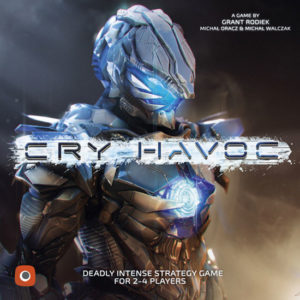 When we got home from Gen Con 2016, the first thing the tired crew here at BGQ did was catch up on some much-needed sleep. However, the second thing we did was write our convention recap. In that article, among other things we discussed our favorite games released at the convention. For me, Cry Havoc was my #1 choice. It was a quick(ish) playing war game where 4 asymmetrical factions are fighting over a planet filled with valuable crystals. From the components to the game play, I was hooked from my first play.
When we got home from Gen Con 2016, the first thing the tired crew here at BGQ did was catch up on some much-needed sleep. However, the second thing we did was write our convention recap. In that article, among other things we discussed our favorite games released at the convention. For me, Cry Havoc was my #1 choice. It was a quick(ish) playing war game where 4 asymmetrical factions are fighting over a planet filled with valuable crystals. From the components to the game play, I was hooked from my first play.
Since then, I’ve been able to play Cry Havoc many more times, so the question is, have my feelings for the game changed after the Gen Con shine has worn off? Time to find out!
Cry Havoc is a 2-4 player war game that takes about 60-90 minutes to play. In our experience, Cry Havoc plays great at any player count.
Game Overview:
In Cry Havoc, players take on the role of one of the games 4 unique factions. The game is played over five (possibly less) rounds, where players will be using cards from their hand to decide their actions. They will be moving, recruiting, building and fighting their way to victory… or defeat.
Cry Havoc is not a game of global domination (although that helps), but of victory points. Players will earn points for winning battles, controlling territories, capturing prisoners and other ways unique to their faction. At the end of the game, the player with the most points is the winner.
Game Components:
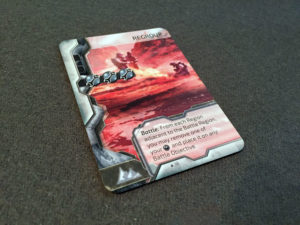
Cry Havoc is published by Portal Games who consistently puts out games with high quality components. And in that regard, Cry Havoc continues the trend as everything in the box is well made and looks great.
My favorite part has to be the miniatures. Each faction gets a set of miniatures sculpted for their particular race. Although part of me wishes that there were different sculpts among the faction figures for added variety, there really isn’t a reason for that in the actual game play, so I understand why they didn’t.
Each player also gets a piles of faction components to go with their miniatures, these range from building tiles, to decks of cards, to cardboard tokens.
Finally, I will say that the rulebook, while not bad, could have been improved a little. We had a number of rule questions after our first play (and a few we just got wrong). There were some important rules that we missed because they weren’t highlighted well enough in the book. Others rules were just missing. Thankfully, Portal Games has already released a FAQ that has cleared up any questions we had. This is a must download if you own the game.
How to Play:
Each player starts the game by selecting one of the game’s 4 factions. In a 2-3 player game, the Trog faction cannot be selected. The board is dual sided, with one side being smaller for the two player game, and the other side used in the 3-4 player game.
I’m going to give you a brief summary of the rules here. If you want the full rundown, you can download a PDF of the rules here, or watch the instructional video.
Cry Havoc is played over a series of rounds (5 or fewer), with each round having 6 phases:
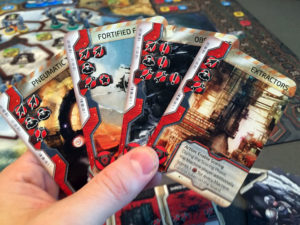
1. Events: Reveal the next event tile. If the next event is Final Scoring, this will be the last round of the game. Initiative is also updated if there were any changes from the previous round.
2. Draw Cards: All players draw 4 cards from their deck, and discard down to 7 if necessary.
3. Action: Each player gets 3 actions per round, which they take one action at a time. On their turn, a player selects one or more cards from their hand and chooses one type of icon to use. For every icon they played, they get to do that action that many times.
Different options include:
- Move: Move one unit to an adjacent space.
- Recruit: Take a unit from your supply and put it on your HQ.
- Build/Activate a structure: Build a structure in a territory you control, or activate a previously placed one.
- Draw 2, Keep 1: These cards can be drawn from your own deck, or from the terrain tactics decks.
- Enable Scoring: Players will score at the end of the round, the player that takes this action will score bonus points per territory controlled. Only one player may take this action per round.
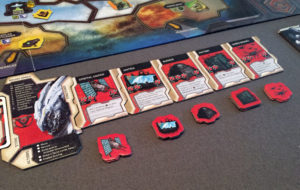
4. Battle Resolution: If a player moves any units into a region with enemy forces, a battle token is placed there and it becomes a battle region. Once a region is a battle region, players cannot move any other troops into there (and are limited to what they can move out). During this phase, all battles are resolved in order of when they were started.
To fight a battle, the attacking player places all their units on the battle board. Then the defender places theirs. Each player can also play 1 tactics card if they have any. The battle board is then resolved from top down:
- Area Majority: The player with the most units in this spot takes control of the region (and gains 2 VPs).
- Prisoners: The player with the most units here collects one enemy unit from the battle board as a prisoner.
- Attrition: Each player kills one unit on the battle board per unit placed here.
After the battle, the winner of the Area Majority puts their surviving units back in the region, the loser must retreat theirs to a friendly region.
5. Prisoners: Each player scores 1VP for each prisoner they have. A player can collect their unit back by losing 2 VPs.
6. Scoring: If enabled, each player earns 1 point for each crystal present in a region they control. The person that enabled scoring earns 1 additional point for each region they control.
Rounds are played out in that manner until final scoring has been completed. At that point, the player with the most points is the winner.
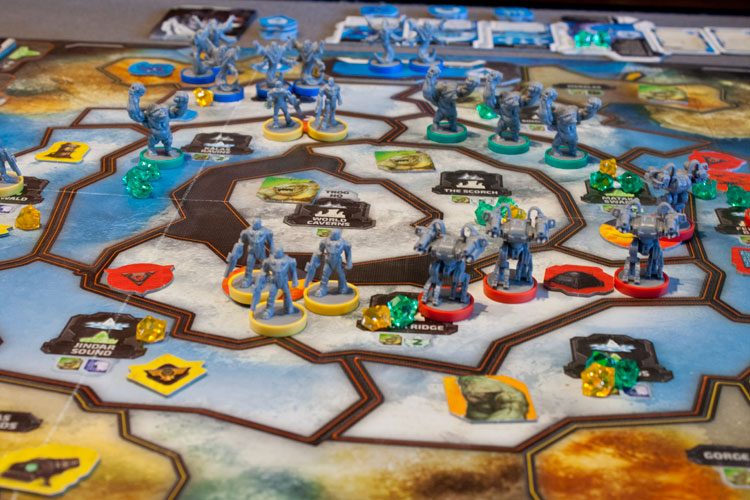
Game Experience:
I really liked Cry Havoc. Part of it is because I’m naturally drawn to asymmetrical games in general, and Cry Havoc does a great job of making each faction feel really unique. I mentioned above that we got a few rules wrong in our first play that kind of messed up the game. But even with those issues, I couldn’t wait to get it back to the table again.
And that’s still true today. I’ve played Cry Havoc many more times so far, at all player counts, and have enjoyed every play. It’s turned into a game that I’m always itching to get to the table. I think it’s because I really want to dive into each faction and figure out what makes them tick. They all feel and play very unique in their approach to the game.
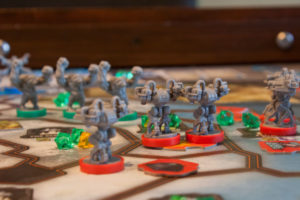
The Trogs are the entrenched defenders that will be in just about every battle in a 4 player game. The can move easily and recruit more units quickly. The humans are mobile, quick to earn VPs and can expand rapidly. The Machines are engines of death. They have multiple ways to destroy other faction’s units outside of combat, allowing them to easily cakewalk through battles. And the Pilgrims are probably the most unusual. They feel like the faction designed for the eurogamer. They want to turtle up and harvest their crystals as quickly and efficiently as possible. If you leave the Pilgrim player alone in a few territories for the whole game, they will probably sneak their way to victory.
And in practice, as you control these factions, you definitely need to approach the game differently than your opponents. If you try to play the Pilgrims as you would the Machines, you are going to get pounded into the ground. Cry Havoc is a low luck game, so maximizing your factions strengths and hiding their weaknesses is key if you hope to emerge the victor.
Asymmetrical factions aside, one of the things I liked most about Cry Havoc is the battle system. It’s one of the most clever takes on combat resolution that I’ve seen. There are three places you can place your units on the battle board and it’s usually impossible to win all three areas. This creates a bit of a meta game where you must try to figure out where your opponent will be placing their units, and if they will be playing a tactics card.
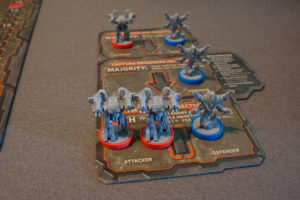
So even in a diceless system, battles aren’t a forgone conclusion. You could move in with a superior force, but the right tactics card could help swing things in your opponents favor. It’s also possible to win control of a region, but not have any troops left to defend it, allowing an opponent to easily retake it next round. The battle system in Cry Havoc is probably one of my favorites to come along in quite a while.
Speaking of battles, Cry Havoc can also be a meat grinder. Expect battles to happen early and often. If you are the kind of player that likes to turtle up and slowly build your power, then this isn’t the game for you. From your very first move into the field, you’ll most likely be fighting. This helps keep the game’s pacing fast and frantic. While the game may take 90 minutes, it sure doesn’t feel like it takes that long.
If I had a complaint about Cry Havoc, it’d be that I can’t play the Trogs in a game less than 4 players. I’m not sure if they were just too hard to balance otherwise, but it’s a bit of a miss for me. I love trying out the nuances of each race, and I only have a chance to use the Trogs in a 4 player game.
The other thing to think about is, due to the asymmetrical nature of the factions, an experienced player is most likely going to have a pretty solid leg up on a new player. Once you learn the nuances of a faction, you become a lot more deadly with them. Knowing how to play a faction to maximize their strengths is a big key to winning that a new player probably won’t know yet.
Finally, Cry Havoc scales really well. I’ve played at all player counts and haven’t had any issues. I think that the scaling works well because with only two players, the game board is smaller, ensuring that combat still happens often between the players. And since players only take 1 action at a time, even with the 4 players I’ve found that turns will still go by quickly.
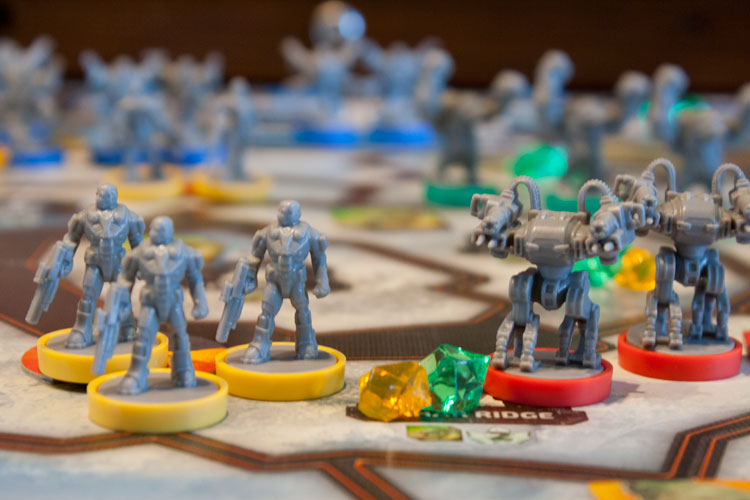
Final Thoughts:
So I asked the question at the start if I still feel the same about Cry Havoc after the Gen Con shine has won off. And the answer is definitely a resounding yes! I’ve immensely enjoyed my games of Cry Havoc and it’s turned into one of those games that I’m always looking to get to the table.
The asymmetrical nature of the game just begs for it to be explored more. Some factions do seem easier to play than others, but that makes me just want to dive into each one even more.
If you are a fan of unique, light war games such as Kemet or Blood Rage, then I think you’d really enjoy Cry Havoc. It plays quickly, feels different from other games out there and it’s battle system is one of my favorites. I’m definitely hoping Portal Games releases some new factions for Cry Havoc in the future, as I’m curious to what else they can come up with. This one is absolutely going to be staying in my collection for a long time to come.
If you’d like to get a copy of Cry Havoc, you can pick it up for about $75.
Final Score: 4.5 Stars – One of my favorite war games to come out in a long time, it’s easy to learn and the asymmetrical factions all feel very different from each other.
 Hits:
Hits:
• Asymmetrical factions all feel and approach the game differently
• The battle board is a great way to handle combat resolution
• Scales great from 2-4
• Game plays quickly and is easy to learn
Misses:
• Can’t play the Trog faction with less than 4
• Rulebook could be better






















